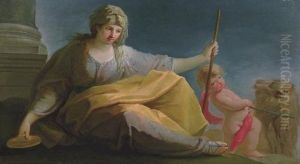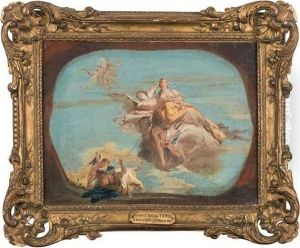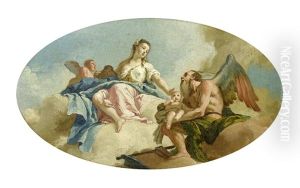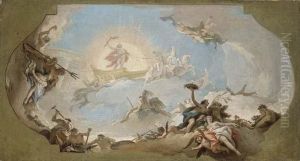Costantino Cedini Paintings
Costantino Cedini was an Italian painter and engraver, born in 1741 in Sebenico, Dalmatia (now Šibenik, Croatia), then part of the Republic of Venice. His artistic journey began in his hometown but soon extended to Venice, where he became a prominent figure in the Venetian art scene of the late 18th century. Cedini is primarily known for his work in the Rococo style, showcasing a delicate and refined approach that was popular during the era. His oeuvre includes religious and mythological subjects, portraits, and allegorical scenes, characterized by their vibrant color palette, intricate details, and dynamic compositions.
Cedini's education and career were deeply rooted in the artistic traditions of Venice. He studied under the guidance of notable Venetian painters, such as Giovanni Battista Piazzetta and Francesco Maggiotto, who played a significant role in shaping his style and approach to art. Throughout his career, Cedini received commissions from various prestigious institutions and individuals, reflecting his reputation and the high demand for his artistic skills. His works were not only appreciated in Italy but also gained recognition beyond the Italian borders, contributing to the dissemination of the Venetian Rococo style across Europe.
Despite his success, Cedini's life was not without challenges. The political and social upheavals that characterized the late 18th and early 19th centuries, including the fall of the Venetian Republic and the Napoleonic Wars, had a profound impact on the art market and the patronage system that artists like Cedini relied on. Nevertheless, he managed to navigate these turbulent times and continued to produce works that resonated with his contemporaries.
Cedini's legacy is preserved through his contributions to various churches and public buildings in Venice and its surroundings, as well as in private collections and museums around the world. He died in 1811 in Venice, leaving behind a body of work that continues to be studied and admired for its elegance, craftsmanship, and historical value. Cedini's art remains an important part of the narrative of 18th-century European art, illustrating the richness and diversity of the Rococo movement and its impact on the development of Western art history.





